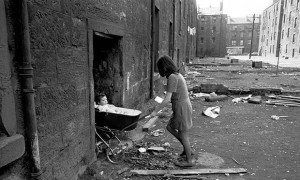Jamie Doward ~ Shelter And The Slums: Capturing Bleak Britain 50 Years Ago

A mother takes her baby inside her condemned tenement block Gorbals 1970. Photograph: Nick Hedges for Shelter
From 1968 to 1972, photographer Nick Hedges toured the country for Shelter. His work galvanised politicians – and now the charity wants to find out what happened to those he portrayed.
At first glance they seem to be the survivors of a besieged city. Standing in front of decrepit buildings that tower over streets absent of cars, they cut abject figures. Children in ragged clothes play on wasteland; a mother and her teenage daughter huddle in their home, a cellar lit by just one light bulb; a father in a dank living room festooned with broken furniture holds his toddler son close to his chest.
But these people have not been bombed into submission. They are not experiencing the horrors of the second world war. They are living in Britain in the swinging 60s, an era that the then prime minister, Harold Wilson, famously promised would deliver material improvements for all, thanks to the “white heat of technology”.
They are the inhabitants of Britain’s slums whose desperate plight, captured by the photographer, Nick Hedges, for the housing charity Shelter, helped alert the public to the woeful living conditions many people were enduring in the country’s neglected inner cities.
Read more: http://www.theguardian.com/homeless-shelter-charity?

